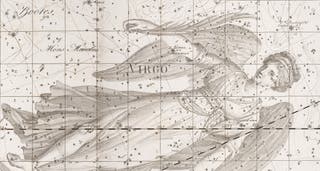Pardies, Ignace-Gaston. Globi coelestis. Paris, 1674.
Pardies was a Jesuit astronomer whose star atlas was published by his colleagues just after his death. The atlas was then reissued sixteen years later, with new information added. Each edition of the atlas is quite scarce, and our Library is fortunate to have fine copies of both.
Pardies' star atlas is stylistically one of the most attractive ever published. Pardies took his constellation figures primarily from Bayer's Uranometria, but since each chart covers a large section of the sky, these figures had to be carefully integrated, which was not an easy task. Pardies' engraver accomplished this task with great success.
The image above shows a detail of Hercules and Serpentarius [Ophiuchus]. The plate from which it is taken shows Hercules, Ophiuchus] Scorpius, Sagittarius, Aquila, and Lyra, and the total ensemble is one of the most stunning compositions in the history of celestial cartography. The bottom left image is a detail of Cassiopeia, which is beautifully done in the Bayer manner.
One gets a good demonstration of the deep continuity of style in depicting the constellations by comparing Pardies' Cassiopeia to the Cassiopeia figure in Grotius's Syntagma Arataeorum, 1600, which was in turn the source of the Bayer image.

